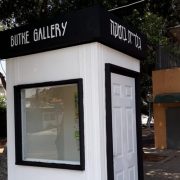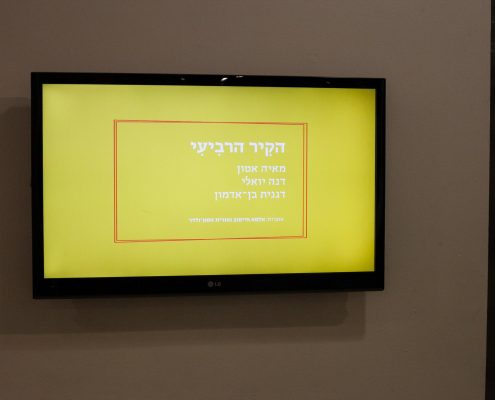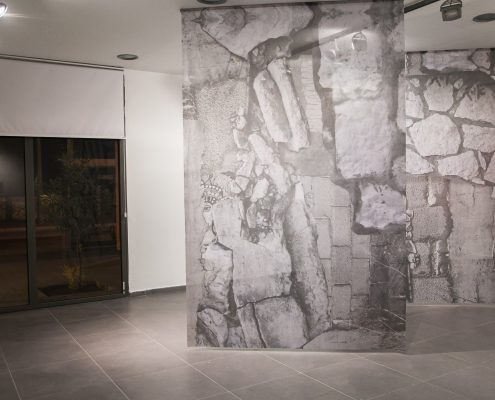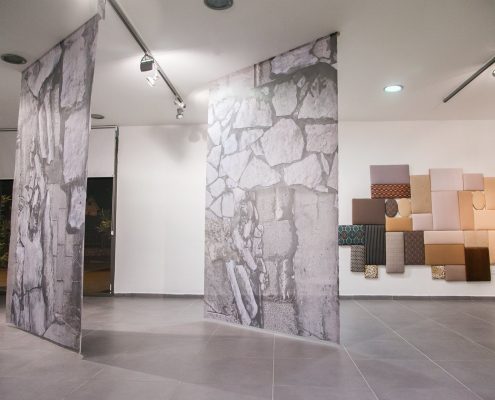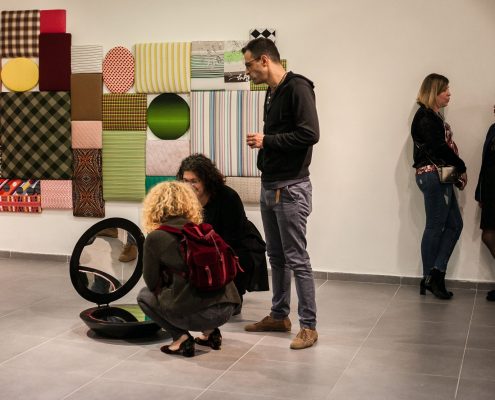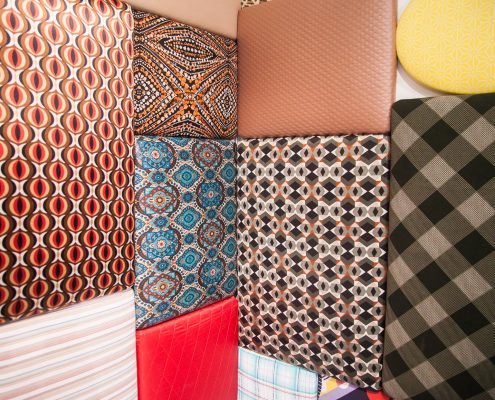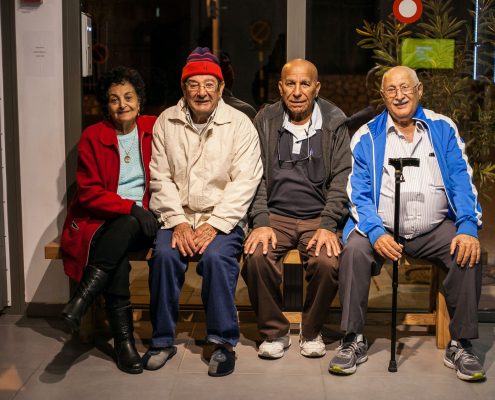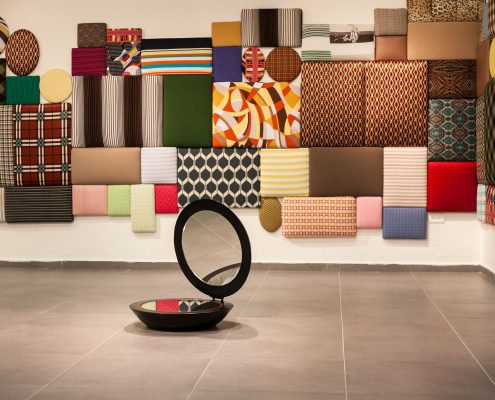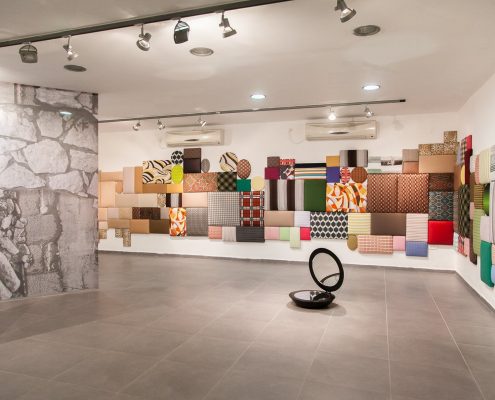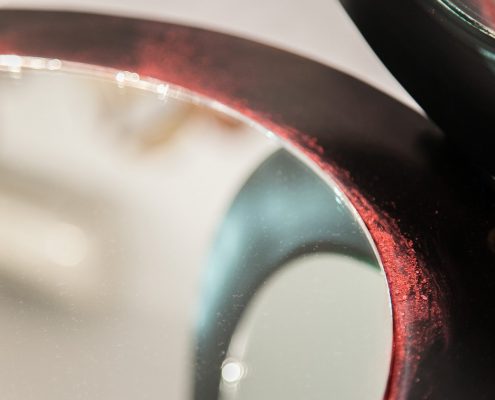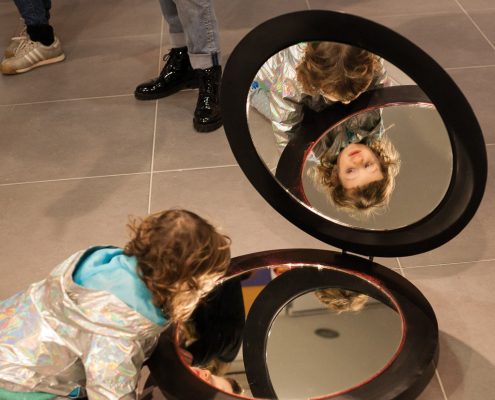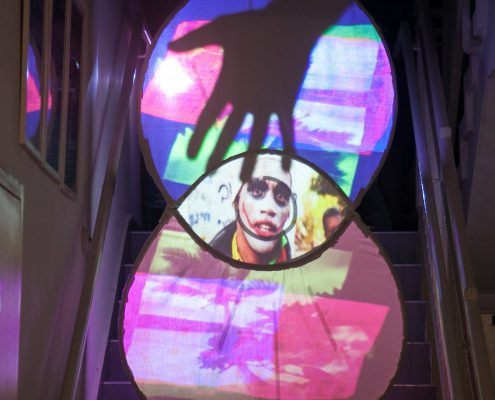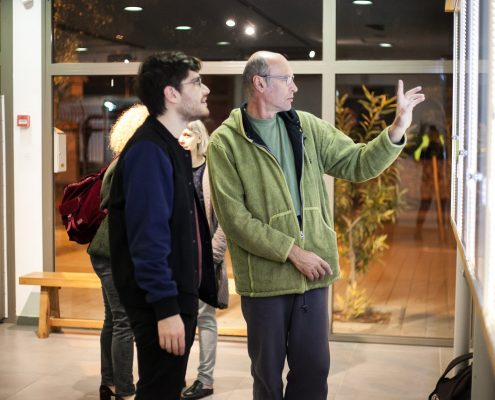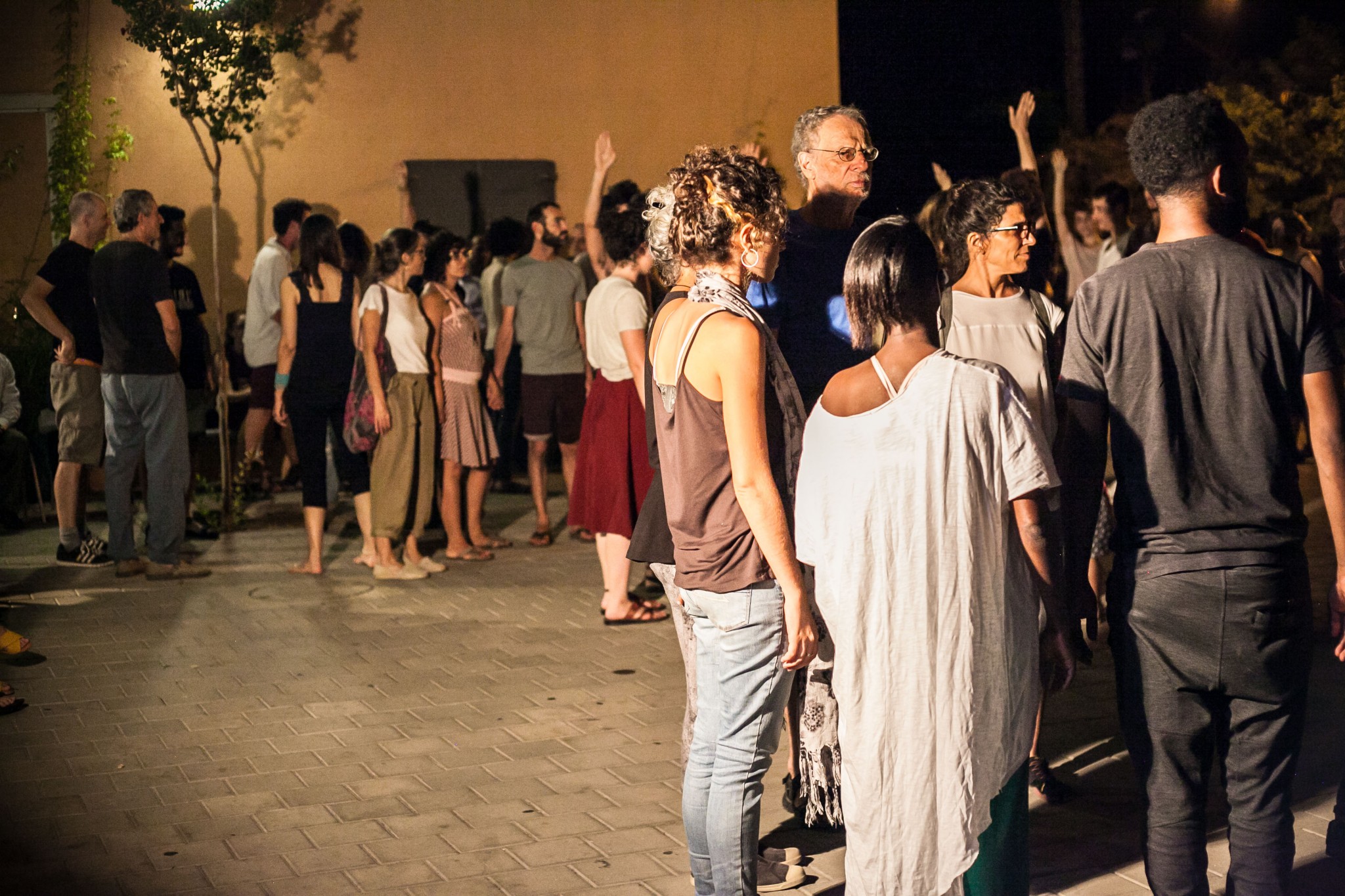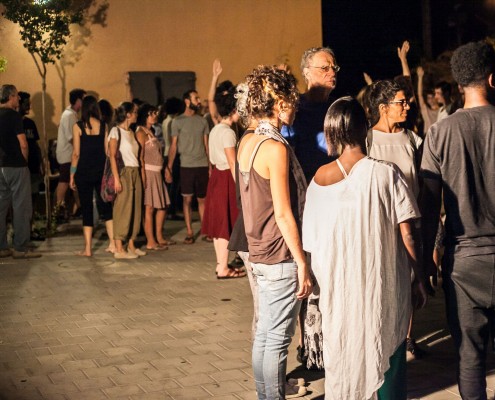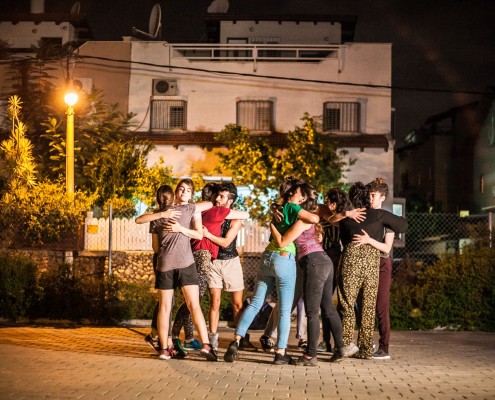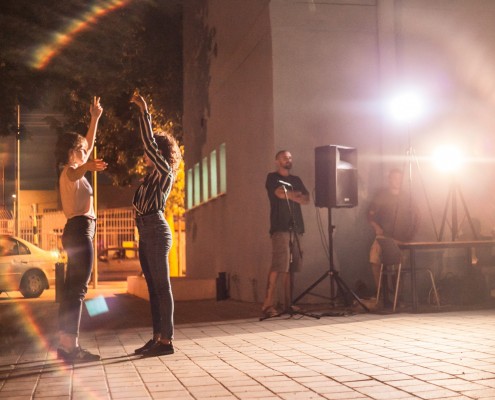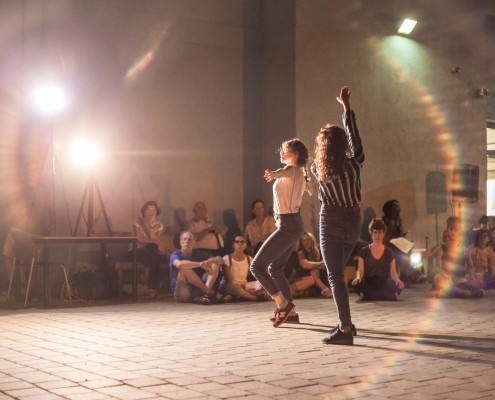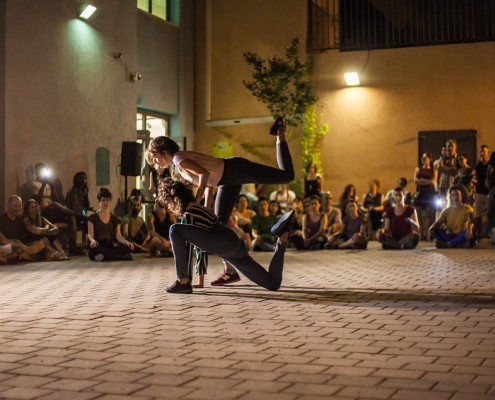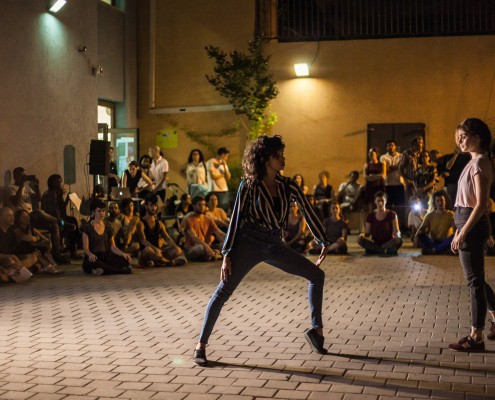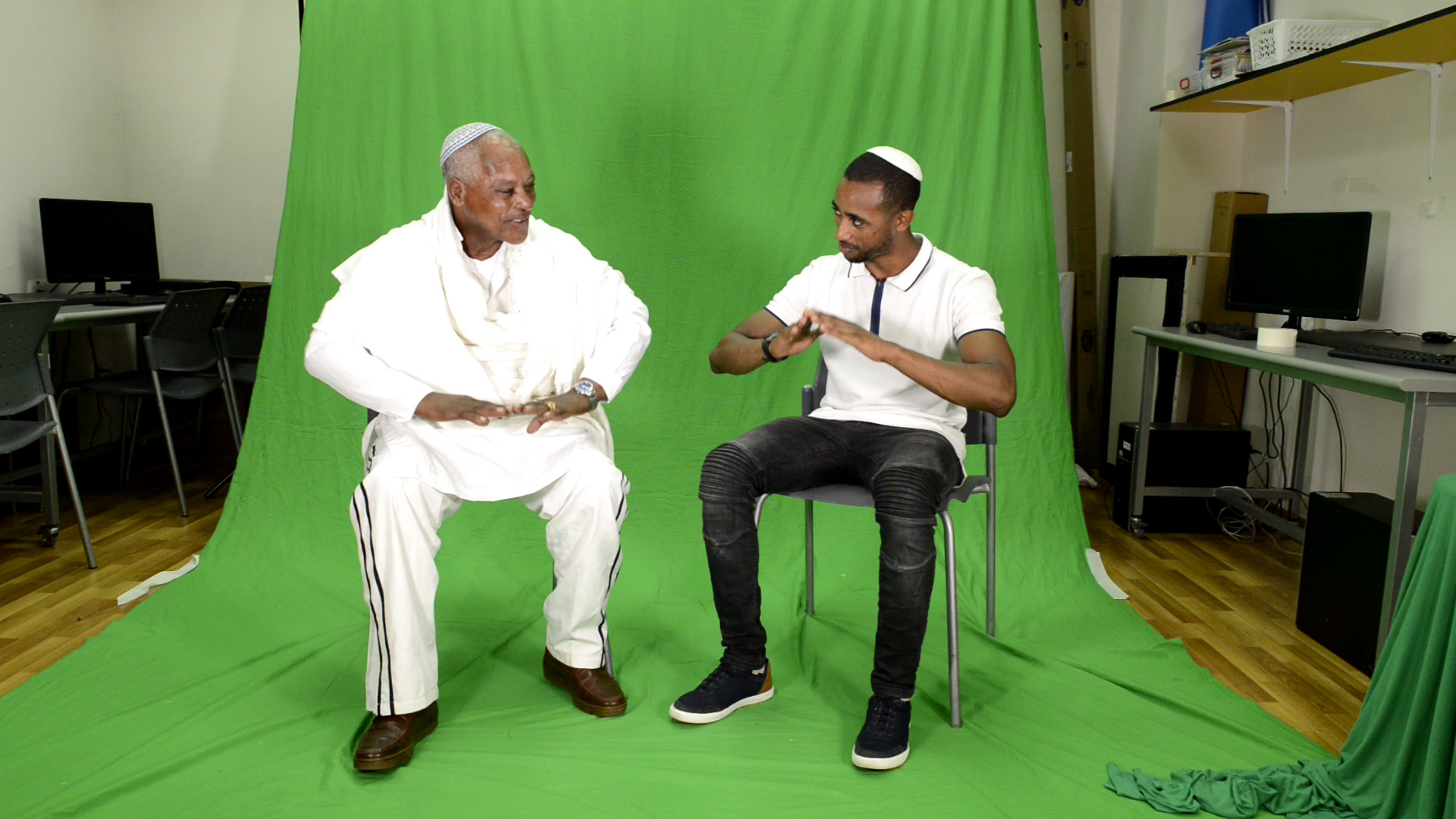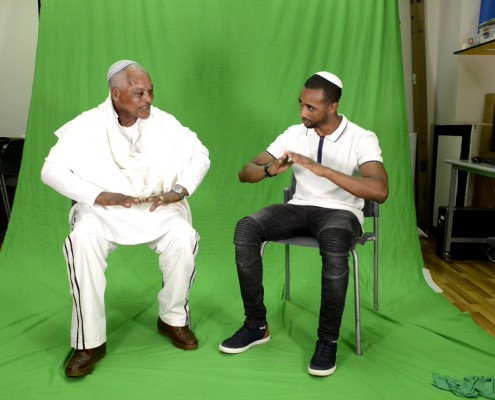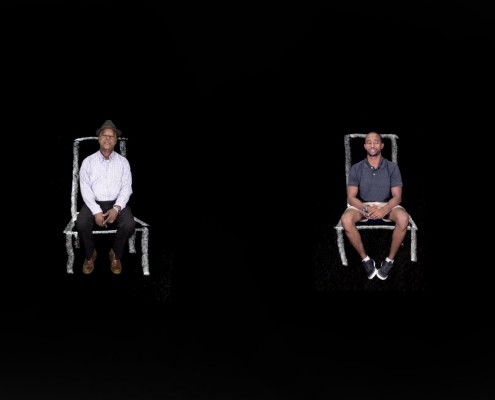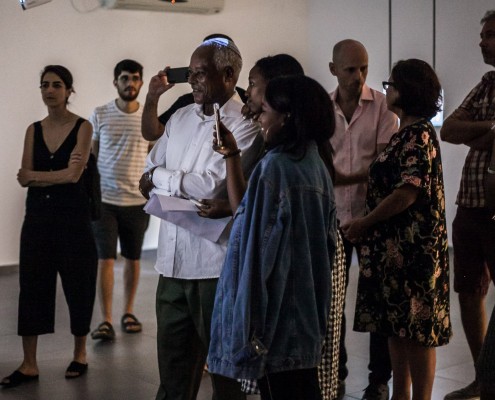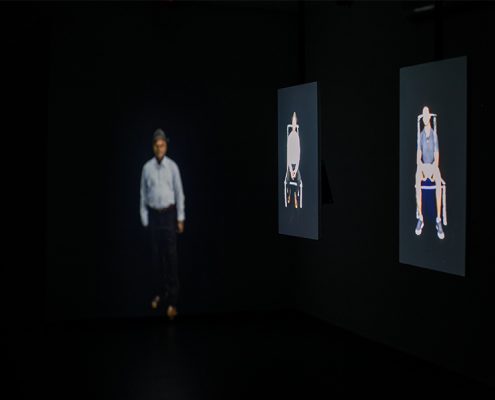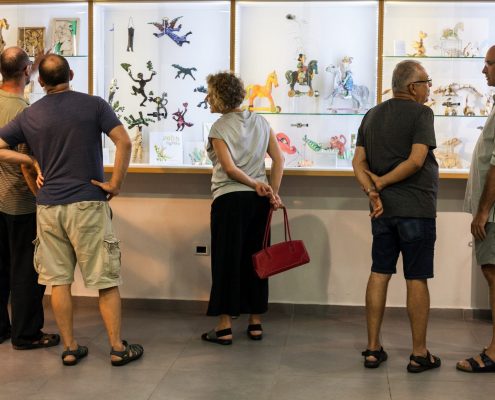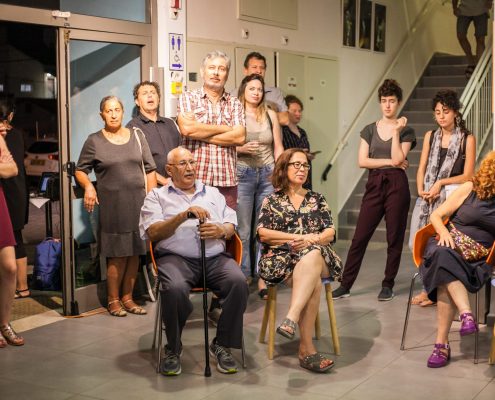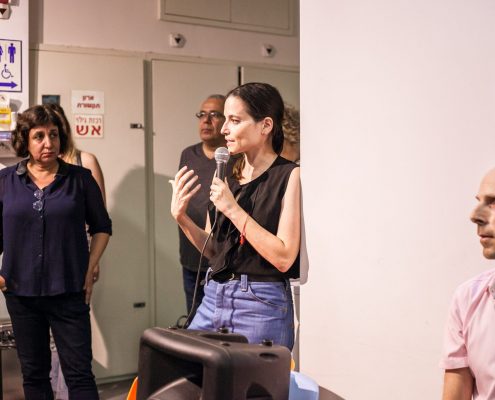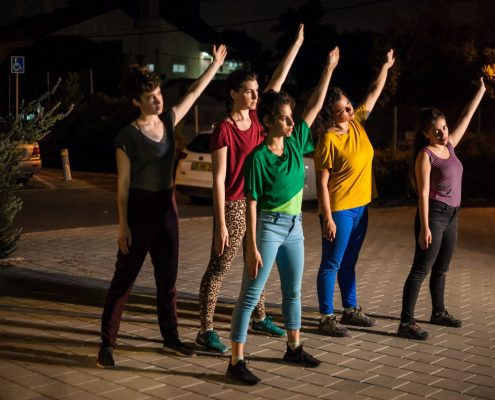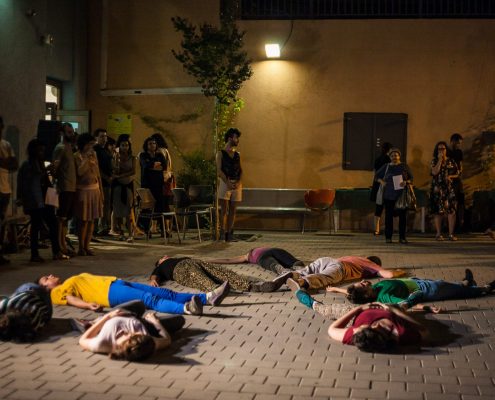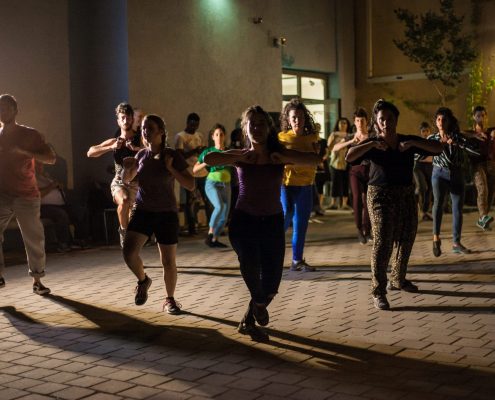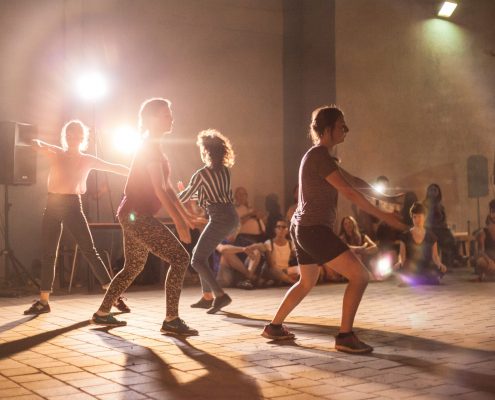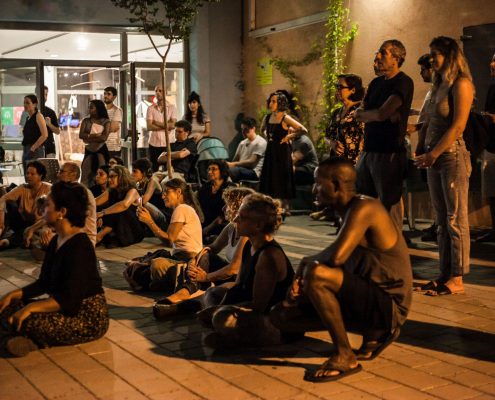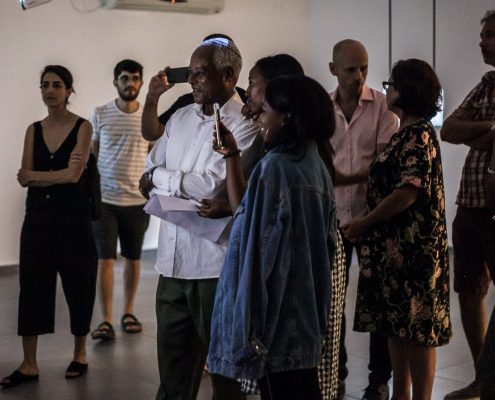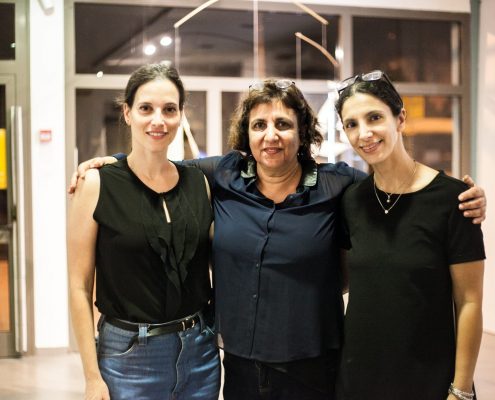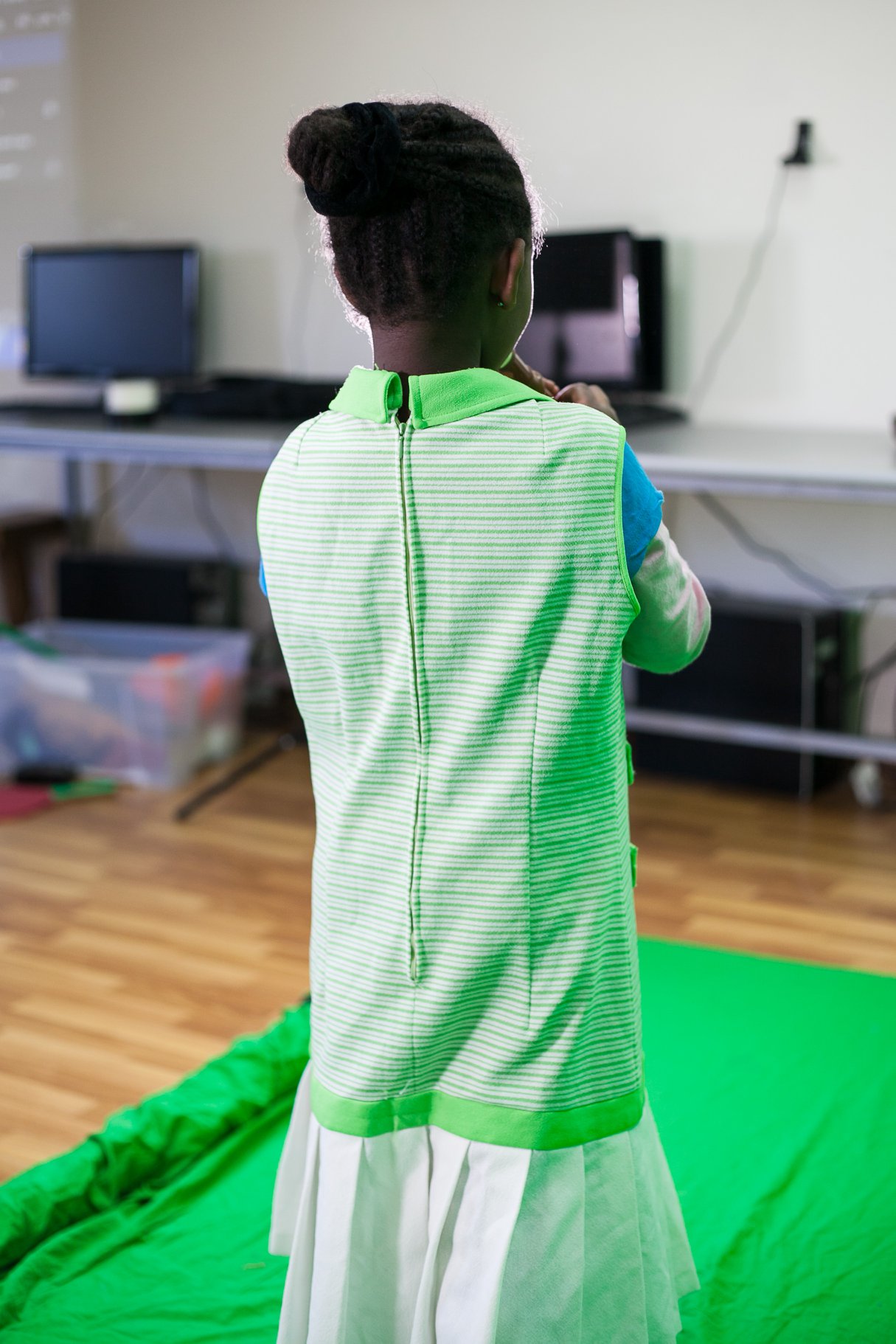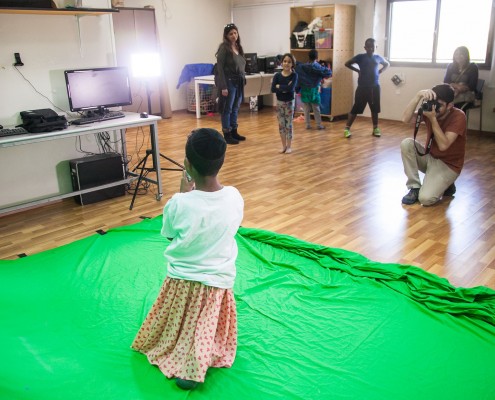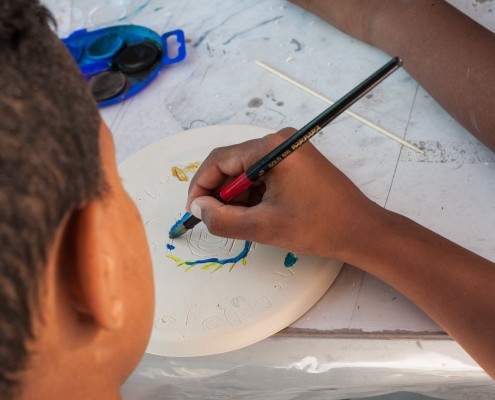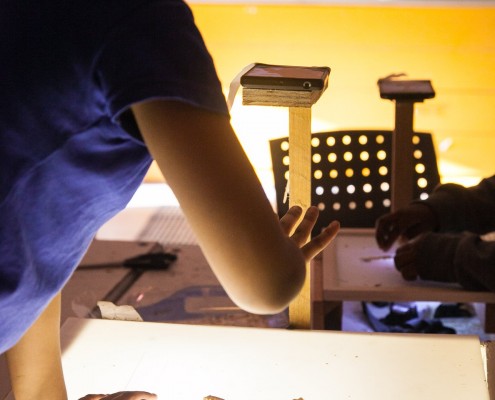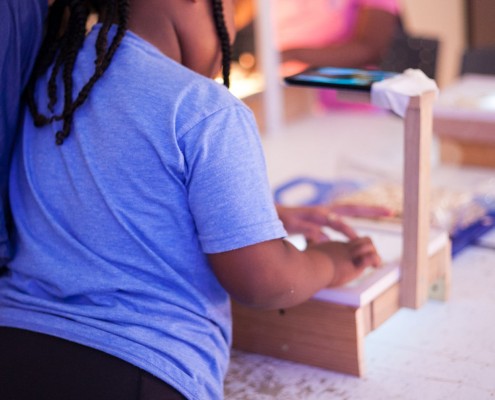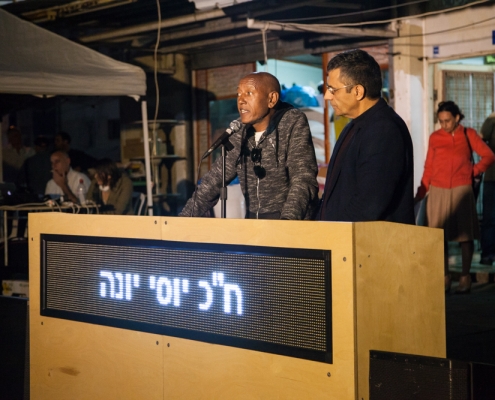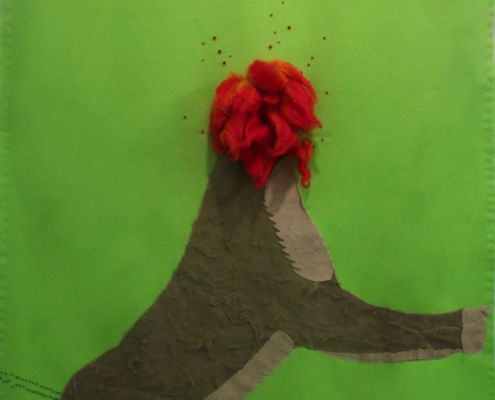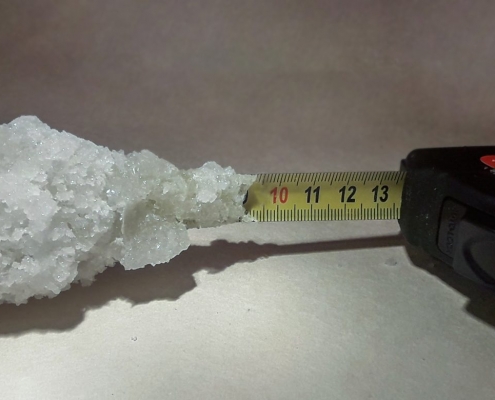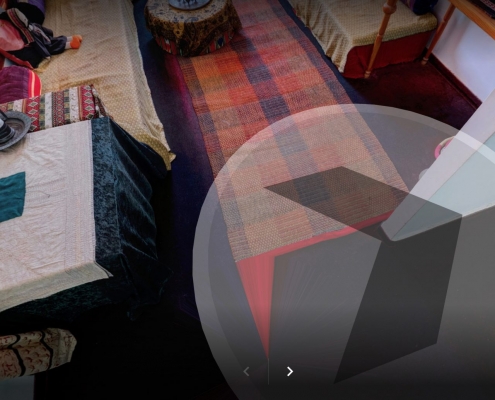הקיר הרביעי, תערוכה | The Fourth Wall, Exhibition
/in ארכיון תערוכות, תערוכות /by art workshopהקיר הרביעי
מאיה אטון, דגנית בן אדמון, דנה יואלי
אוצרות: אלפא חיימוב ואורית חסון ולדר
15.12.2018
*English follows below
“הקיר הרביעי” הוא מונח מתחומי התיאטרון והקולנוע המתאר קיר שקוף ובלתי נראה החוצץ בין הבמה או הסצנה המצולמת לבין הצופה. המונח נקשר למהות תערוכה זו שבה הפְּנים (של בית, של רגעים אינטימיים הרשומים בזיכרון) מתערבב עם החוץ (רחוב, זהות לאומית, דברים המוגדלים פי כמה וכמה ונראותם בולטת ומוחצנת). בתערוכה, הקיר הרביעי אשר הגן על הפְּנים מפני החוץ, מתמוסס ונעלם, והצופה כמו צועד פנימה אל התוֹך הרך והפגיע של עבודות האמנות.
הולדת התערוכה ברצון להתעכב על הממד הצוּרני-אדריכלי של שכונת רמת אליהו שבה נמצאים הסדנה וחלל התצוגה. הצורות, הצבעים והדגמים שקלטו שלוש האמניות במרחב הציבורי – חזיתות הבניינים, המבנים התעשייתיים והמרכזים המסחריים – הם נקודת המוצא של התערוכה. אחרי שסיירו בשכונה, תרגמו האמניות את שראו בהקשרים החברתיים, התרבותיים והפוליטיים שהם חלק מהשפה האמנותית הייחודית לכל אחת מהן.
שכונת רמת אליהו היא אחת מערי החולין(1): שכונת מגורים כמוה יש רבות, שכונות שבהן מתנהלים חיי היום יום ללא זוהר ומסתורין. החזית האפרורית המודרנית, היא מאיץ ליוזמות פרטיות זעירות של הוספת אזורי צבע חמים שנועדו לשפר את סביבת המגורים: צורות אדמדמות על סורג, החלפת מעקה מרפסת סטנדרטי במעקה דקורטיבי בצבעי בורדו, קיר ורוד-מסטיק המסמן מבחוץ דירה אחת במרכזו של בלוק דירות אפור.
מאיה אטון רואה בתוספות צבע ספונטניות אלה ניסיון להוסיף רעננות ויופי- כמו איפור הפנים בסומק בגוון ורדרד. הצבעים שדהו בשמש מכמירי לב, שריד לאיפור שנמחה ונמרח, ולחילופין מעלים על הדעת אדם שהסמיק, ומנסה בכל כוחו לא לבלוט. סומֶק, פסל הפודרייה שבנתה אטון, אביזר איפור אינטימי שהוגדל לממדים על-שימושיים, מצויד באבקת סומק בגוון ורוד עתיק הדומה לצבעים שמופיעים ברחובות השכונה. בפודרה הדחוסה מוטבע סמל גרפי הלקוח מקישוטים גיאומטריים שבהם הבחינה האמנית על חזיתות הבתים וכך מונצחת החזית הציבורית באבקה העדינה לשימוש אישי.
בְּקִיעַ, מיצב הדגלים הגדולים של דנה יואלי הוא תעתוע בין זיכרון אישי לאתוס לאומי. קירות רכים – ספק גדרות אבנים, ספק קירות הנצחה – שכמותם נמצא בכל עיר ובזיכרונות הילדות בארץ. יואלי מגדילה צילומים של שברי אבנים ובלוקים מקירות וגדרות בשכונת רמת אליהו ומדפיסה אותם על בד לשילוט חוצות. בין אבני הגדר המוגדלות חבוי דיוקן קטן של קיסרית האימפריה הביזנטית תיאודורה, כפי שהונצחה בפסיפס לפני מאות שנים בעיר וורונה שבאיטליה. הצילום היה תלוי בבית משפחתה של האמנית והוא מהווה עבורה זיכרון ילדות חשוב. האמנית הטמינה קטע מהדיוקן שנצרב בזיכרונה הפרטי – עין אחת, רבע כתר, ושליש מהפנים הקיסריות – בין האבנים והשברים של זיכרונות ילדות קולקטיביים. כמו הפודרייה של מאיה אטון שגדלה פי כמה, גם הדגלים התופסים את כל גובה חלל הגלריה מאירים רגע מוכר ובנאלי באור גדול. במעבר למדיום צילומי הפכה התחושה של אבן מחוספסת למשטח חלק, בעוד השברים והאבק של המיתולוגיה השכונתית מתמזגים עם ההוד וההדר של המיתולוגיות העתיקות.
כשהיא נזכרת בנסיעה לאורכם של הרחובות בשיכונים שבעיר ילדותה באר שבע, מדמיינת דגנית בן אדמון את חזית הבניינים הארוכה המסתירה מאחוריה עשרות דירות, כמוסות חיים המקודדות בדגמים, בצורות ובצבעים שבחדרי המגורים המשפחתיים ובחדרי השינה. הטקסטיל הביתי – הביגוד, הווילונות, המפות – מחצין את התשוקה לבלוט ולהתהדר במָקום שבו נוכחים דווקא חזרתיות אפרורית ושכפול. הבד, בהיותו חומר העוטף את הגוף מרגע היוולדו, מדבר בשפה אוניברסאלית של מגע וראייה מישושית(2) במיצב Inside-Out מייצרת האמנית, במהלך של טרנספורמציה מודרניסטית המערבת הפשטה וצורות גיאומטריות, “ארכיון בדים” שבאמצעותו היא חושפת בפני הצופים את פְּנים הדירות הבנויות זו לצד זו ובו בזמן מנכיחה את הרחוב- הפְּנים מושלך אל החוץ. כמו דנה יואלי, גם בן אדמון בונה קיר רך- אך בעוד הקיר הגמיש של יואלי נבנה על ידי הקצנה וחיקוי, בזיקה לזיכרון קולקטיבי של הנצחה ומיתוס לאומי, הקיר הרך והמרופד של בן אדמון נבנה כחפץ הגנה על יקיריה גם בידיעה שזהו חיקוי בלבד.
אלפא חיימוב
(1)ד”ר רועי ברנד, The Urburb – קטלוג הביתן הישראלי של הביאנלה ה- 14 לאדריכלות בוונציה (עורכים ר’ ברנד וא’ שלום), הוצ’ שטרנהל ספרים, 2014, עמ’ 276.
(2)את ההשראה לצמד מילים זה קיבלתי מתוך מאמרה של אירנה גורדון “החוש הטקסטילי”.
גורדון אירנה, (2015), החוש הטקסטילי, בתוך: ברטל,א’, זהבי ר’, ארליך ע’ (עורכים), מחשבות על קראפט (עמ’ 3387-406), תל אביב: רסלינג.
The Fourth Wall
Maya Attoun, Dganit Ben Admon, Dana Yoeli
Curators: Alfa Haimov and Orit Hasson Walder
Opening: Saturday evening, December 15, 2018
The Fourth Wall is a concept from theatre and cinema describing an invisible transparent wall dividing the stage or photographed scene from the viewer. The term is linked to the essential nature of this exhibition in which interiors (such as homes, or intimate moments engraved in memory) blend with the external (the street, national identity, enlarged several times to exaggerate their visibility and make them stand out). The “fourth wall” which protects the interior from the outside melts away and disappears in this exhibition, leaving the viewer to seemingly stride right into the artworks’ soft, vulnerable core.
The exhibition was conceived in the wish to take time to consider the aspect of architecture in the Ramat Eliyahu neighborhood, where the Art Workshop and Gallery are located. The forms, colors, and patterns that the three artists perceived in the visual public space formed by the residential, industrial, and commercial buildings constitute the exhibition’s point of origin. After touring around the neighborhood, the artists translated what they saw into the sociopolitical-cultural contexts that form part of each one’s unique art language.
The Ramat Eliyahu neighborhood is one of Israel’s “urburbs”[1] : a fragmented hybrid of urban and suburban, a residential neighborhood among many in which daily life goes about without any glamour or mystery. The modernist grey façade is a catalyst for small private enterprises in which residents have added areas of warm color designed to improve the environment, such as reddish forms of a window bar, a decorative burgundy-colored railing replacing a standard balcony railing, a bubblegum-pink wall marking the outside of a single apartment at the center of a grey cinderblock housing project.
Maya Attoun considers these spontaneous additions of color an attempt to add freshness and beauty – like adding pinkish rouge to the face. The colors that have faded in the harsh sunlight, remnants of makeup that smeared and was erased, often bring to mind a person who blushed but makes utmost attempt not to stand out. “Somek”[compact],Attoun’s sculpture made of shapes of makeup or blusher compacts, an intimate accessory enlarged to an unusable size, is filled antique rose blush similar to the colors appearing in the neighborhood streets. The dense powder is stamped with a graphic logo taken from the geometric decorations the artist noticed on the building facades, thus memorializing the public façade with the delicate rouge meant for personal use.
“Bekia” [splittable] the large flag installation by Dana Yoeli is an illusion between personal memory and national ethos, with soft walls which may be read as stone walls or perhaps walls of a memorial such as found in each Israeli city and in the childhood memories of most Israelis.Yoeli enlarged photographs of broken stones and blocks from walls and fences in the Ramat Eliyahu neighborhood then printed them on sheets used for large-scale outdoor billboards. Among the enlarged images of stones making up the wall is a small portrait of the Byzantine Empress Theodoraas commemorated in a centuries-old mosaic in Verona, Italy. The photograph was hanging in the artist’s childhood home, constituting an important memory for her. The artist hid a portion of the portrait, indelibly imprinted on her private memory – just one eye and a quarter of a crown, a third of her face – among the broken stones of collective childhood memories. Like Maya Attoun’sblusher compact enlarged several times, the flags are huge, taking up the full height of the gallery space, illuminating a familiar banal moment. The transition to the medium of photography transformed the sensation of rough stone surface into a smooth area while the fragments and dust of the neighborhood’s mythology blend with the glory and splendour of ancient mythologies.
Dganit Ben Admon remembers riding through the streets of Beersheva as a child, passing by the mass housing blocks. The memory evokes thoughts of how the long facades of the project concealed dozens of apartments. Filled with life, the housing blocks are encoded in the patterns, forms, and colors of the living rooms and bedrooms: domestic textiles of clothing, drapery, tablecloths, externalizing the passion to stand out and show some beauty in a place in which the repetitive greyness and replication are strongly present. Fabric, as material wrapping the body from the moment of birth, speaks in a universal language of contact and tactile vision[2].In her installation Inside-Out, the artist creates a “textile archive” through a modernistic her modernistic transformation blending abstraction and geometric shapes. Through this archive she reveals to the viewers the interiors of the apartments stacked up and placed side by side, while at the same time, making the street present in a process in which the interior is projected outward. Like Dana Yoeli, Ben Admon also builds a soft wall – but while Yoeli’s flexible wall was built through imitation and taking things to the extreme in its link to the collective memory of commemoration and national mythos, Ben Admon’s soft, upholstered wall has been constructed as an object protecting her dear ones, even though she knows that it is merely an imitation.
Alfa Haimov
[1] Dr. Roy Brand, in The Urburb: Patterns of Contemporary Living, Catalog of the Israeli Pavilion of the 14th Venice Biennale for Architecture, Brand, R. and A. Shalom (eds.), (Sternthal Books, 2014), p. 276.
[2] My inspiration for the term is from Irena Gordon’s article on “Woven Consciousness” (2015) in Mahshavot al craft (Thoughts on craft), Bartal , U., R. Zehavi, and E. Ehrlich (eds.), (Tel Aviv: Resling), pp. 387-406.
רננה רז ותנועת תרבות , פרוייקט שהות אמן | Dance Workshop
/in אירועים קהילה, ארכיון קהילה, עמוד ראשי, קהילה /by art workshop*English follows below
העבודה, שהחזרות עליה נערכו בסטודיו בסדנא לאמנות, עוסקת בצורות וחוקרת את ההיבטים הכוריאוגרפיים ואת ההקשרים התוכניים והרגשיים הגלומים בצורות: צורות כאובייקט גיאומטרי וצורות כשיקוף וייצוג של רעיונות או ערכים. העבודה בוחנת כיצד אנו מתבוננים בצורות, שאלת קדימות הרעיון על הצורה ולהיפך, באילו צורות מתלכדות קבוצות ובאילו הפרט ואת האופנים בהם צורות נחוות בראי הזמן.
רקדנים: רוני אדר, נדב אייזנר, זואי ברקן, דורין גל, מיכל לובין, גילי לניר, שקד מוכיח, מאיה מנטל, לבנה רגב, מעיין רוזנברג ושחר שיבולי
רננה רז: כוריאוגרפית, רקדנית ויוצרת רב-תחומית עבודתה מאופיינת במקוריות ובחדשנות. ביצירותיה משלבת דיסיפלינות שונות כתיאטרון ופרפורמנס. בעבודותיה בוחנת את מקומו והשפעתו של ההקשר על האופן בו מתקבל התוכן. זוכת פרס שר המדע התרבות והספורט ליוצרים צעירים לשנת 2002, 2003 ו-2006. זוכת פרס רוזנבלום לשנת 2006. בין עבודותיה: “YouMake ReMake” הכולל תגובות מבוימות לקטעי יוטיוב המתרחשות על הבמה ו”השימוע”‘, אירוע תיאטרלי בעקבות פרשת המורה אדם ורטה. יצירותיה מוצגות בארץ ובעולם.
Opening night featured Culture Form/ Tzurat Tarbut by Choreographer Renana Raz and dancers from the Tenuat Tarbut/Cultural Movement dance group.
Rehearsals were held in the studio at the Ramat Eliyahu Art Workshops site for this work engaged in forms, studying the choreographic, emotional, and content associations embodied in forms: forms as geometric objects and as reflecting and representing ideas or values. The piece examines how we observe forms, asking which came first – the idea or the form? In what forms do groups take shape, and in which details and ways are forms experienced as seen through time?
Dancers: Roni Adar, Nadav Eisner, Zoe Barkan, Doreen Gal, Michal Lubin, Gili Lanir, Shaed Mochiah, Maya Mantal, Levana Regev, Maayan Rosenberg, Shahar Shiboli
Renana Raz: Choreographer, dancer, multidisciplinary creative artist, her work is characterized by originality and innovation. Raz integrates various disciplines such as theatre and performance in her dance, examining the place and impact of context on the way in which content is accepted. Awarded the Minister of Science, Culture and Sport Prize for a Young Artist for 2002, 2003, and 2006. Her works include “YouMake ReMake,” with staged responses to YouTube clips onstage, and “The Hearing,” a theatrical production based on the affair of the teacher Adam Varta. Renana Raz’s works are presented in Israel and abroad.
העבודה, שהחזרות עליה נערכו בסטודיו בסדנא לאמנות, עוסקת בצורות וחוקרת את ההיבטים הכוריאוגרפיים ואת ההקשרים התוכניים והרגשיים הגלומים בצורות: צורות כאובייקט גיאומטרי וצורות כשיקוף וייצוג של רעיונות או ערכים. העבודה בוחנת כיצד אנו מתבוננים בצורות, שאלת קדימות הרעיון על הצורה ולהיפך, באילו צורות מתלכדות קבוצות ובאילו הפרט ואת האופנים בהם צורות נחוות בראי הזמן.
רקדנים: רוני אדר, נדב אייזנר, זואי ברקן, דורין גל, מיכל לובין, גילי לניר, שקד מוכיח, מאיה מנטל, לבנה רגב, מעיין רוזנברג ושחר שיבולי
רננה רז: כוריאוגרפית, רקדנית ויוצרת רב-תחומית עבודתה מאופיינת במקוריות ובחדשנות. ביצירותיה משלבת דיסיפלינות שונות כתיאטרון ופרפורמנס. בעבודותיה בוחנת את מקומו והשפעתו של ההקשר על האופן בו מתקבל התוכן. זוכת פרס שר המדע התרבות והספורט ליוצרים צעירים לשנת 2002, 2003 ו-2006. זוכת פרס רוזנבלום לשנת 2006. בין עבודותיה: “YouMake ReMake” הכולל תגובות מבוימות לקטעי יוטיוב המתרחשות על הבמה ו”השימוע”‘, אירוע תיאטרלי בעקבות פרשת המורה אדם ורטה. יצירותיה מוצגות בארץ ובעולם.
מייפל ואגוז | Maple & Walnut
/in אודות, ארכיון תערוכות, הגלרייה של כל הדברים, עמוד ראשי, תערוכות /by art workshopשירת גברים, תערוכה | Men Singing , Exhibition
/in אירועים קהילה, ארכיון תערוכות, גלריית הסדנא לאמנות, עבר /by art workshopשירת גברים / מישל פלטניק
אוצרת: אורית חסון ולדר
*English follows below
רקיעות ברגליים, מחיאות כפיים ושירה הם רק חלק מרפרטואר המחוות במיצב הווידיאו של האמן מישל פלטניק, אשר נוצר במיוחד לגלריית הסדנא לאמנות.
כשהם ישובים או ניצבים, צועדים במקום או עומדים, משחזרים שלושת הגברים שירים וסיפורים ששמעו בילדותם ובצעירותם. שם התערוכה רומז לאיסור על שירת נשים והדרתן ממקומות ציבוריים, שעולה לכותרות בתדירות הולכת וגדלה, ומולו מוצבת דווקא שירה אזרחית של גברים במרחב הפרטי. אל מול אפליה של נשים והדרתן מהספרה הציבורית מספר האב דווקא על תחושות של הזנחה שחש כגבר עולה בקהילה האתיופית ביחס לטיפוח הנשים בנות הקהילה.
התערוכה מוקדשת לגברים בני דורות שונים מן הקהילה האתיופית הנוכחים בחלל בקולם ובשירתם. בפינות שונות בחלל החשוך הם “מאירים” כמו גחליליות על יחידות הקרנה אינטימיות. האובייקטים (מוטות מתכת דקיקים) משתלשלים מן התקרה וכמו צומחים מן הרצפה ומזכירים בגודלם ובצורתם משוטי סירה. בחלק ממיצב הווידיאו נעצרת התנועה ושני הגברים נותרים קפואים לכמה שניות בעוד האדם השלישי ממשיך לשיר ולזוז ולהפך. כמו בשחזור אירוע היסטורי, גם כאן קיימת חזרה מאוחרת לסיטואציה מהעבר אשר נחרטה בזיכרון. השחזור באמצעות הדימוי הנע מקיים חזרה כפולה: הגברים חוזרים אל הרגע בילדותם והוא מוקלט בשנית. האדם אשר נטל חלק באירוע המוקדם מעניק לו למעשה משמעות חדשה. כך שירת הבנים שנולדו בישראל או עלו אליה, מעניקה פרשנות מחודשת לטקסטים של השירים. הופעתם מחדש שרים באמהרית, כגברים צעירים הגאים בתרבות האם ודוברי השפה, מהווה פעולה אישת כמו גם פוליטית.
פלטניק, עולה מצרפת, עוסק במרבית עבודותיו ביחסים בין אבות ובנים ומבקש לפענח יחסים בין דוריים חוצי יבשות וארצות באשר הם. הצטלבות הביוגרפיה של המהגרים הצעירים מאתיופיה ותהליך ההגירה השונה מאוד של האמן חושפת את רגעי המעבר וההחלפה של שפת ארץ המוצא בשפה העברית. העבודה שואלת מה נרשם בזיכרון, מה ניתן להעביר ולתווך בשפה אחרת לעומת מה שנשמט בדרך ואובד.
עבודת הווידאו בהשתתפות: בלאי אבבה, ג’מרה אבבה, אגר אספה\
בגלריה של כל הדברים: מייפל ואגוז
ב”גלריה של כל הדברים”, חלל תצוגה מחוץ למעגלי האמנות ובהשראת חדרי הפלאות, מציב בוריס קרביץ, מאייר ומעצב תפאורה, צעצועי עץ שחלקם קשורים לעולם הילדות ומקצתם אינם תמימים וילדיים כלל. בין פסליו: דמויות של לוחם, בעלי חיים ומטריושקה בדמותו. בארון מוצבת גם עבודה הנושאת גוון פוליטי ונושאת את השם “צב הריסה”, מעין הכלאה בין צב לדחפור הריסה. קרביץ מתייחס בעבודה לחוויה שחווה בביקוריו בבקעה אצל חקלאים ערבים ולצווי הריסה הניתנים למשפחות רועי הצאן בצפון בקעת הירדן.
בערב הפתיחה יתקיים מופע המחול: צורת תרבות של חברי קבוצת תרבות עם הכוריאוגרפית רננה רז העבודה, שהחזרות עליה נערכו בסטודיו בסדנא לאמנות ,עוסקת בצורות וחוקרת את ההיבטים הכוריאוגרפיים ואת ההקשרים התוכניים והרגשיים הגלומים בצורות: צורות כאובייקט גיאומטרי וצורות כשיקוף וייצוג של רעיונות או ערכים. העבודה בוחנת כיצד אנו מתבוננים בצורות, את האופן בו צורות נחוות בראי הזמן .העבודה שואלת באילו צורות מתלכדות קבוצות ובאילו הפרט ומה קודם למה רעיון לצורה או צורה לרעיון.
רקדנים: אדר רוני, אייזנר נדב, ברקן זואי, גל דורין, לובין מיכל, לניר גילי, מוכיח שקד,מנטל מאיה, רגב לבנה, רוזנברג מעיין ושחר שיבולי
על רננה רז – רננה רז: כוריאוגרפית, רקדנית ויוצרת רב-תחומית עבודתה מאופיינת במקוריות ובחדשנות. ביצירותיה משלבת דיסיפלינות שונות כתיאטרון ופרפורמנס. בעבודותיה בוחנת את מקומו והשפעתו של ההקשר על האופן בו מתקבל התוכן. זוכת פרס שר המדע התרבות והספורט ליוצרים צעירים לשנת 2002,2003,2006. זוכת פרס רוזנבלום לשנת 2006.
בין עבודותיה: YouMake ReMake הכולל תגובות מבוימות לקטעי יוטיוב המתרחשות על הבמה, ‘השימוע’, אירוע תיאטרלי בעקבות פרשת המורה אדם ורטה, יצירותיה מוצגות בארץ ובעולם.
Men Singing / Michel Platnic
Curator: Orit Hasson Walder
The festive opening reception was held on Sat. evening, Sept. 1, 2018
***
Men stamping their feet, clapping hands, and singing are only some of the repertoire of gestures in artist Michel Platnic’s new video created especially for the Ramat Eliyahu Art Workshop Gallery.
Whether sitting or standing, marching or standing in place, the three men present songs and stories recalled from childhood and youth. The title of the exhibition hints at the prohibition of men hearing singing by women, and the women’s exclusion from public spaces, on the rise in headlines in Israel. In contrast are the songs by male laymen in the private space. When referring to the exclusion of women, the father narrates a story about his feelings of being neglected by the community as a male immigrant from Ethiopia, since it is the women who are mostly being nurtured by the women of the community.
The exhibition is devoted to the multiple generations in the Ethiopian community present in the space through their voices and singing. They “illuminate” various corners of the darkened space like fireflies as the spotlights shine on them, creating intimate spaces. The size and shape of the thin metal rods slinking down from the ceiling and which seem to grow out of the floor are reminiscent of oars. In some sections of the video, two out of the three men are “frozen” for a few seconds while the third continues to sing and move, and vice versa. As in a re-enactment of an historical event, here, too, the men re-enact a past situation imprinted in their memories. The re-enactment by the moving figure is a double repetition: the men repeat the moment from their childhood, which is then re-recorded. The man who participated in the earlier event adds a new meaning to the event. Songs by the sons born in Israel or who immigrated to Israel provide a new interpretation to the texts. The reappearance of these songs in Amharic sung by young men, Amharic speakers proud of their mother tongue and cultural heritage, constitutes a personal as well as a political act.
Michel Plotnic, a multidisciplinary artist who immigrated from France, engages in intergenerational relationships, seeking to decode relationships crossing continents and countries in most of his works. The juncture of the biography of the young immigrants from Ethiopia with the artist’s own very different biography exposes the moments of transition and replacement of one’s native language with Hebrew. The video interrogates memory, what and how it is recorded, what can be transmitted and mediated in another language compared to what is left out on the way and lost.
Participants in the video: Belay Abeba, Jamara Abeba, Agar Asepa.
***
In the Gallery of All Things: MAPLE & WALNUT
The Gallery of All Things is an alternative exhibition space in the spirit of the 19th century “cabinet of wonders.” Boris Kravitz, illustrator and costume designer is exhibiting wooden toys, some of which are associated with childhood while others are not at all innocent or childish. Among his sculptures are warrior figures, animals, and a self-portrait on a matriyushka – nestling dolls. In the cabinet is a political work with the title a pun in Hebrew – Demolition Order / Turtle, a hybrid between a turtle and bulldozer used for demolition. Kravitz refers to his experience in Baka-al-Gharbiyeh visiting Arab farmers, and witnessing the demolition orders given to sheep-herding families in the northern Jordan Rift.
***
Opening night featured Culture Form/ Tzurat Tarbut by Choreographer Renana Raz and dancers from the Tenuat Tarbut/Cultural Movement dance group.
Rehearsals were held in the studio at the Ramat Eliyahu Art Workshops site for this work engaged in forms, studying the choreographic, emotional, and content associations embodied in forms: forms as geometric objects and as reflecting and representing ideas or values. The piece examines how we observe forms, asking which came first – the idea or the form? In what forms do groups take shape, and in which details and ways are forms experienced as seen through time?
Dancers: Roni Adar, Nadav Eisner, Zoe Barkan, Doreen Gal, Michal Lubin, Gili Lanir, Shaed Mochiah, Maya Mantal, Levana Regev, Maayan Rosenberg, Shahar Shiboli
Renana Raz: Choreographer, dancer, multidisciplinary creative artist, her work is characterized by originality and innovation. Raz integrates various disciplines such as theatre and performance in her dance, examining the place and impact of context on the way in which content is accepted. Awarded the Minister of Science, Culture and Sport Prize for a Young Artist for 2002, 2003, and 2006. Her works include “YouMake ReMake,” with staged responses to YouTube clips onstage, and “The Hearing,” a theatrical production based on the affair of the teacher Adam Varta. Renana Raz’s works are presented in Israel and abroad.
מדיה חדשה , פרוייקט חברתי | New Media Course
/in ארכיון קהילה, סדנאות, קהילה /by art workshopסדנת “יוצרים ונהנים” היא פרוייקט משותף במסגרת תוכנית הדרך החדשה בהנחיית האמן דור זליכה לוי. הסדנא עסקה בתיעוד סיפורים בוידיאו שנאספו מהורי הילדים ומתארים את הנרטיב המשפחתי. הפרויקט למעשה היווה בסיס לחיזוק הקשר הורה- ילד(ה) ואיפשר לצאת יחד למסע היכרות אישי ותרבותי. הסדנא עסקה בצילום ובידיאו אשר תיעד את נרטיב המשתתפים, והומחז על ידם. הסדנא היתה חלק ממסע טיפולי רחב יותר באמצעים טכנולוגים, קרי טיפול באמצעות פוטותרפיה.
את הפרוייקט יזמו לשכת הרווחה מערב, המינהל לשילוב חברתי והסדנא לאמנות רמת שליהו.
נערות יוצרות בטקסטיל , פרוייקט חברתי | Community Textile Workshop
/in ארכיון קהילה, סדנאות, קהילה /by art workshopאפיקומציה , אירוע אנימציה קהילתי | Passover community animation event
/in אירועים, אירועים קהילה, ארכיון קהילה, חינוך, עמוד ראשי, קהילה /by art workshopשכונה בסכנת הכחדה, עיתון הארץ, 13.2.18, נעמה ריבה Naama Riba, A neighbourhood in danger of extinction, Haaretz, Feb. 13, 2018,
/in אודות, כתבו עלינו /by art workshopטרזן על סדין, תערוכה | Tarzan on a Sheet , exhibition
/in Uncategorized, ארכיון תערוכות, גלריית הסדנא לאמנות, עבר, עמוד ראשי, תערוכות /by art workshopטרזן על סדין הסדנא לאמנות רמת אליהו 2017
אמנים : יעל בן שלום, ליאור גריידי, צאלה גרינברג, עומר קריגר, הלל רומן
‘בחלון אמנית: נועה טורקניץ
אוצרת: אורית חסון ולדר
*English follows below
שם התערוכה “טרזן על סדין” נשען על זיכרון ילדות של ותיקי שכונת רמת אליהו שצפו בסרטי “טרזן” ו”זורו” שהוקרנו על סדינים במרחב הציבורי של השכונה. לתערוכה קדמו פעולות אמנות ציבוריות שנערכו בשכונה במסגרת פסטיבל ״פינוי בינוי תתחדש אליהו״ ואחריו.
התערוכה מבקשת לבחון מה קורה להיסטוריה ולמיתולוגיה מקומית בעיבוד למדיום ולדור אחר ובאילו אופנים ניתן לעסוק בחומרי ארכיון מבלי להיתפס לנוסטלגיה. בנוסף ייבחן הפוטנציאל הקיים במפגש של אמנים עכשוויים עם עדויות וזיכרונות של המורשת העדתית לייצור תרבות חיה ופועמת.
במסגרת התערוכה מוזמנים התושבים להתארח במיצב מיוחד שנבנה בשיתוף ותיקי השכונה, מוצבים בניינים עשויים סוכר שנתרם על ידי תושבי השכונה ותלויים על החלון דגלים בהשראת סיפוריה של תושבת השכונה רינה, ששמה הוחלף במצוות בעלה לשרה כדי שיביא מזל טוב.
בעבודת וידיאו שנערכה במיוחד מתועד אירוע של שידור חי” של “רדיו קול המדינה הבאה” פעולה ציבורית של האמנים עומר קריגר והלל רומן (במסגרת “פסטיבל פינוי בינוי- תתחדש אליהו) בוידיאו ניתן לעקוב אחרי רצף של דיונים בעברית וSaveבאמהרית בין הדוברים נציגי מנהלת פינוי בינוי, קס סמאי אליאס – קס העדה בראשל”צ, ח״כ יוסי יונה – המחנה הציוני, ממקימי הקשת הדמוקרטית המזרחית ותושבי רמת אליהו.
בעבודתה של יעל בן שלום יוקרן על גבי מסך מגע סיור וירטואלי במוזיאון למורשת יהודי תימן. המוזיאון, שהוקם ב-1970 על ידי סבה של האמנית בנתניה ונותר כמעט ללא שינוי מאז, צולם ב-360 מעלות על ידי צלם מוסמך של google street view באופן שמאפשר לצופה לשוטט בו בלי להיות נוכח במקום פיזית. העבודה מבקשת לעורר שאלות אודות תפקיד המרחב הפיזי של מוזיאון מורשת בימינו ויחסי הגומלין בינו לבין המוזיאון המדומיין המוצג לצופה בגלריה.
המיצב של צאלה גרינברג מציע דגם של שכונת רמת אליהו העתידית. הדגם עשוי כולו מסוכר ונוצר בהשראת דיווחים וכתבות שהתפרסמו בשנים האחרונות בעיתונים ובאתר העירייה סביב תכנית הפינוי בינוי. הסוכר ששימש חומר גלם ליצירה נאסף על ידי האמנית בתרומה מדלת לדלת. תהליך האיסוף מתועד בסרט שמהווה חלק מהמיצב, שנע בין ניסוי קולינרי בסוכר וניסוי מדעי במצבי צבירה משתנים.
האמן ליאור גריידי הציב במרחב הגלריה שולחן שתכנן בשיתוף עם ותיקי השכונה: יוסף גולן,סעדיה גרמי,איציק ששון ומרדכי ברזילי .השולחנות, המאזכרים שולחנות בית ספר, יזמנו סיטואציות של אירוח אשר במסגרתן יפגשו התושבים על כוס קפה ויאספו חומרים ארכיונים, כשהתושבים הוותיקים משמשים כספרנים ומידענים. על השולחן חקוקים שמותיהם וכינוייהם של הוותיקים (איציק קלרה, דני חסיבה) שמביאים לידי ביטוי תופעה בה הם החליפו את שמות משפחתם המסורתיים בשמות אימותיהם, שהיו הדומיננטיות במשפחה.
בחלון אמנית הפונה לרחוב תציג נועה טורקניץ’ עבודה הבנויה משני חלקים בטכניקה מעורבת המזכירה שמיכות טלאים ,מעין דגלים ארוכים שנוצרו בהשראת סיפוריה של תושבת השכונה ילידת 1920 רינה (שרה) נתן המייצרים מיתולוגיה ייחודית לה וליוצאי תימן בתקופתה.
Tarzan on a Bedsheet
Ramat Eliyahu Art Workshop, 2017
In the Gallery: Yael Ben Shalom, Leor Grady, Tseela Greenberg, Omer Krieger, Hillel Roman
In the Artist’s Window: Noa Turkenitz
Curator: Orit Hasson Walder
The exhibition Tarzan on a Bedsheet is based on the childhood memories of the old-timers of the Ramat Eliyahu neighborhood of watching Zorro and Tarzan films on improvised screenings on bedsheets in the neighborhood’s public spaces. Preparations leading up to the exhibit included public art actions in the neighborhood before, during, and after the Pinui/Binui Festival referring to the neighborhood renewal project.
The exhibition is an attempt to examine what happens to local history and mythology when processed in a different medium by a different generation. In what ways can we engage in archival material without falling into the trap of nostalgia? The artists further explore the potential to create a living, breathing culture existing in the encounter between contemporary artists and testimonies and memories which are part of the heritage of a particular ethnic community.
The exhibition invites local residents into a special installation constructed in collaboration with the neighborhood old-timers, comprising buildings made of sugar cubes contributed by local residents. Flags inspired by Rina’s stories hang in the windows, including Rina’s own story of how her husband ordered her to change her name to Sarah to bring good luck.
The public art actions by Omer Krieger and Hillel Roman as part of the Voice of the Future State Radio Station – Kol Hamedina Habaa, are been documented in a video-art piece edited especially for the exhibition. It depicts the live-streaming event held during of the Pinui/Binui Festival on Neighborhood Renewal, especially discussions in Amharic and Hebrew between representatives of the Pinui/Binui Neighborhood Renewal administration, Kes Samai Elias, religious leader of the Ethiopian community in Rishon Lezion, and between MK Yossi Yonah of the Mahaneh Hatzioni, one of the founders of the Eastern Democratic Rainbow, and local residents.
Yael Ben Shalom’s work will be screened on a touch screen in the Museum of the Heritage of Yemenite Jewry, founded in 1970 in Netanya by the artist’s grandfather. It has hardly changed since them. The 360° photography was filmed by an authorized photographer of Google Street View, enabling viewers to go on a virtual tour of the Museum without being physically present. Ben Shalom’s artwork seeks to arouse questions on the function of a heritage museum in this day and age and the reciprocal relations between the image of the museum presented to viewers in the gallery space.
Tseela Greenberg presents an installation proposing a model of the future Ramat Eliyahu neighborhood, made entirely of sugar, created in the wake of reports and features in the press in recent years and posted on the Municipality’s website on the neighborhood renewal project which intends to clear out residents and rebuild it. The sugar was gathered in door-to-door donations by the artist, a process documented in the film which is part of the installation, part culinary experimentation with sugar and part scientific experiment with changing physical states of material.
Leor Grady’s table placed in the gallery space was designed by the artist in collaboration with veteran neighborhood residents Yosef Golan, Saadia Garami, Itzik Sasson, and Mordechai Barzilai. The tables, reminiscent of schoolroom desks, invoke situations of hospitality. During these encounters, residents can meet over a cup of coffee, collect archival materials, encounters in which the old-timers act as librarians and information technologists. The veteran residents’ names and nicknames cut into the tables (Itzik Clara, Danny Hassibah) reflect the phenomenon of people changing their traditional family names to bear their mother’s name, as the mothers were dominant in the families.
The Artist’s Window facing the street showcases Noa Turkenitz’s work in mixed media made in two sections, bringing to mind patchwork quilts. They form what look like long flags, inspired by Rina (Sarah) Natan, a local resident born in 1920, creating a mythology unique to Rina and other of her contemporaries who are part of the Yemenite community.
יצירת קשר
שאול המלך 5, ראשון לציון, 75602
שעות פתיחה
משרדים
א’-ה’, 8:00-16:00
גלריות
ימים א'-ה', 10:00-14:00
יום ב', 17:00-19:30

